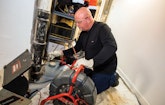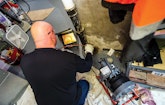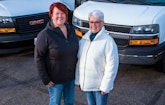
The DrainPro team includes (from left) Justin Householder, Paul Crook, Joe Clark, owners Carol Rimorin and Melissa Martin, Pat Martin, James Collins and Sean Wyatt.
Interested in Cleaning?
Get Cleaning articles, news and videos right in your inbox! Sign up now.
Cleaning + Get AlertsBuilding a successful drain cleaning business without any advertising may sound about as plausible as an old clay pipe sewer line with no tree root intrusions. But that’s exactly how DrainPro in Baltimore grew from a small, one-truck outfit in 2011 to a company that now generates more than $1 million in annual gross revenue.
The formula for that growth was simple. Rather than paying big bucks to advertise its drain cleaning services to businesses and homeowners, the company instead opted to cultivate relationships with plumbers who avoid drain cleaning because of the labor and equipment expenses, explains Pat Martin, general manager of DrainPro.
“We knocked on plumbing company doors and told them we won’t letter our trucks so we can work as (anonymous) subcontractors for them,” Martin says. “We asked them to give us a shot … and it kind of took off from there.
“The plumbers liked it because they didn’t have to deal with all the woes associated with hiring people and buying equipment to do drain cleaning, as well as the fixed costs that come with all that. And if a job goes south, all of the risk is on us, not the plumber.
“The bottom line is it worked. And that’s how DrainPro became the largest drain cleaning company in the Baltimore area that no one has ever heard of.”
Sheer necessity
Company owners Carol Rimorin and her daughter, Melissa Martin (Pat Martin’s wife) felt they had no other choice than to consider this bold, unconventional strategy, he explains.
“Developing plumbers as customers required very little investment,” Pat Martin says. “We barely had enough money for equipment back then, much less money for advertising. So there weren’t many other choices other than going no-ad.”
At one point, they did divert from that no-ad strategy. When the company was about 4 years old and on sounder financial footing, management decided to give advertising a try. But the company soon had to hire more office personnel to handle the resulting increase in call volume, Martin says.
“So at that point, we not only had the extra expense of the advertising, but also the cost of hiring more people,” he says. “Our call-closing ratio went from one-to-one to five-to-one … much less efficient than getting one call from a plumber for one job.
“So after about 1 1/2 years, we said, ‘Why don’t we just go back to doing what worked for us back in the beginning?’”
Over the years, the company has acquired residential and commercial customers that call DrainPro directly, with no plumber as a middleman. The split between residential and commercial customers, such as hospitals, apartment complexes, colleges and the like, is about 50/50.
“Some plumbers don’t want to handle certain jobs, so they refer customers to us and then they become our customers,” Martin says. “Now about 60% of our work comes from working as subcontractors for plumbers, and the rest of our business comes from our own customers.”
To cost-effectively promote the company’s drain services to plumbers, Melissa Martin will periodically make trips to local supply houses with one of the company’s trailer jetters in tow. The jetter usually sparks conversations with interested plumbers, as well as other tradespeople and facility management people.
A focus on drains
Three people established the company: Rimorin, who was a retired electrical utility employee before joining the firm; Melissa Martin, who was working as a dispatcher for the drain division of a plumbing company; and Joe Clark, a friend of Melissa who worked as a drain cleaning technician at the same company where Melissa worked.
“The company they worked for was a miserable place to work, so they decided to start their own,” Pat Martin says. “Joe was the first employee. The company focused on drains because that was his area of expertise, not plumbing.
“They named the company DrainPro because drains are what they did and the ‘Pro’ reflected the professionalism they wanted to bring to the industry.”
Growth came quickly, with the company adding nearly one service vehicle a year since its inception in 2011. “It’s been a booming economy, so we don’t pat ourselves on the back too hard,” Martin says. “But we’ve gone from one truck to six and from two employees to eight. And our revenue target in 2019 was $1.6 million.”
As another measure of growth, Martin says the company now offers a full range of benefits, including 401(k) retirement funds; a low-deductible health insurance program in which the company pays 100% of the premiums; vision, dental and life insurance; and paid vacations. “We couldn’t even talk about those things when we first started out,” he says.
Differentiating through equipment
Investing in reliable and technologically advanced equipment, as well as keeping it well maintained, has also spurred growth. Today the company’s roster of equipment includes two trailer jetters manufactured by US Jetting, a 4018 model (4,000 psi at 18 gpm) and a 4025 (4,000 psi at 25 gpm); a Brute 150 trailer jetter built by Jetters Northwest (150-gallon water tank and a 4,000 psi at 9 gpm pump); and three JM-1000 Mini-Jet water jetters (1,500 psi at 1.4 gpm) built by General Pipe Cleaners. Technicians use nozzles made by Enz Technik, StoneAge (Warthogs) and Chempure (Root Rat).
The company also owns numerous RIDGID sectional machines: K-50s, K-60s, K-1500s and K-5208s. It also has invested in a RIDGID K9-204 FlexShaft drain machine, a Zip-Zip flex-shaft drain machine from Drain Rehab Solutions, and a Mini Miller drain machine made by Picote Solutions.
In addition, DrainPro relies on RIDGID Scout and Radiodetection RD7000 and RD8000 pipeline locators and a dozen RIDGID SeeSnake inspection cameras (one standard-size unit, one nanoReel, four microReel units and six Minis).
“We like to have multiple cameras on the trucks as opposed to having one and moving it from truck to truck as needed,” Martin says. “It’s just more efficient. Plus, this variety of cameras allows us to handle different pipe diameters.”
Having multiple cameras instead of one also simplifies job assignments because dispatchers don’t have to waste time figuring out which truck has the one camera, he adds, noting that the company uses dispatching and scheduling software developed by Jobber. “Some people think it’s crazy to buy that many cameras, but it gets the job done,” he says.
The company’s six service vehicles are all the same: Either GMC Savana vans or their Chevrolet equivalent, Express vans. Martin likes them because they’re heavy duty enough to tow trailers but small enough to fit into parking garages with low ceilings.
Having all the same vans also makes it easier to buy parts — things like wiper blades, brake pads and rotors, oil filters and so on — and keep track of inventory. Plus, the company can buy parts in bulk, which is more cost effective, Martin says.
The company hires a mobile mechanic to service its vehicles. After he finishes his work, new parts get ordered right away to replace whatever was used. “In our shop, we also keep four new tires already mounted on rims,” he says. “So if we need new tires, we just jack up a truck and we’re out the door in 20 minutes.”
Maximize efficiency
To keep technicians well equipped and working, the company foots the bill for replacing lost or damaged cutting heads on sectional drain machines. That runs counter to some companies that make their technicians pay for new cutting heads, a philosophy that just doesn’t make sense to Martin.
“One thing we hear the most from our guys, almost word for word, is that their last employer never had any new heads on hand for their machines,” he says. “They had to buy their own and often couldn’t afford it. So they’d use the snake to poke a hole in the clog and drain it, rather than thoroughly clean it.
“We replace cutting heads, no questions asked. We make sure that no matter what our guys are prepared, which has contributed to our growth. Other contractors tell me I’m crazy because a company could lose hundreds of dollars a year by paying for cutting tools. But if you don’t have the proper tools, your callback volume goes up and over time you get distraught employees.”
Eventually, the unhappy technicians quit and then the company has to buy a new cutting head anyway. So companies really gain nothing by not supplying technicians with heads, he says. “If you go through all that work to find and train employees, why give them reasons to leave?”
Another growth-generator is the company’s stance regarding time spent on jobs. Instead of “nipping at technicians’ heels” to get jobs done quickly, Martin says technicians are told to take whatever time is needed to do a good job. This avoids profit-killing callbacks that end up consuming more time than if a technician took time to do a job right the first time, he says.
Management also encourages technicians to do little things for customers, like grab a newspaper at the end of a driveway and bring it to the front door, put things back in a kitchen sink when they’re finished working and so forth. “Once a customer called and said our technician washed the dishes that that were in the sink,” Martin says. “Another time one of our guys helped a customer unload mulch from a vehicle.
“It’s the little things you do for customers that count. Some companies might reprimand guys for doing that because they could’ve spent that time working on another job.”
Slow, steady growth
Looking ahead, Martin says the company isn’t interested in rapid, exponential growth. Management is concerned that fast growth would erode the good relationships the company has cultivated with employees and clients by potentially degrading service.
“I once read something that said that the enemy of good is ‘better,’” Martin says. “In other words, if you’re doing things really good, trying to make them ‘better’ sometimes can backfire and mess things up.
“You get into growth mode and then say, ‘Wow, we were so much better at five trucks, or even one truck. Our ultimate goal was to become no bigger than a three-truck operation, and here we are at six trucks. So it’s not that we’re against growth, you just have to manage it.”
There’s also the possibility of adding news services to meet the changing needs of customers. But one thing is certain: Technicians will keep working from their vanilla-white, unlettered trucks — stealth drain cleaners operating in plain sight.
Don’t be afraid to fire customers
One of the biggest business mistakes management made in the early years of establishing DrainPro, a drain cleaning outfit in Baltimore, was clinging too long to customers who didn’t pay bills on time.
The drill is all too familiar for many business owners in the trades: Larger clients can take months and months to pay their bills, and contractors feels they have little leverage to demand timely payment, fearing they’ll anger the client and lose the business.
“We tried to grow our company by accommodating large customers who didn’t pay on time,” Martin says. “But when you have to wait six to nine months to get paid, your company essentially becomes a bank that gives away drain cleaning services.
“We already work at a little bit of a discount (in order to obtain subcontracting work) from plumbers who need drain cleaning services,” he adds. “Not every service call is a home run — margins are tight.”
Furthermore, sending out 10 or 15 emails and making a dozen phone calls to try to get clients to pay their bills sucked up time and taxed office personnel, he says.
Around 2015, after four years in business, DrainPro took action. “Our accounts receivable were through the roof, and cash flow was down to almost zero,” Martin recalls. “Everyone had money except for us. This forced us to tell customers they’re on 30-day payment schedule.”
If a customer didn’t pay on time, DrainPro required credit card payments going forward. And if that didn’t work, the company stopped doing business with those customers.
Interestingly enough, the policy didn’t hurt business as much as management feared. Martin estimates DrainPro lost about half of the slow-paying customers, but he says the other half started paying on time.
“I don’t know why. Maybe they respected us more for standing up for ourselves, or maybe they didn’t want to lose us as a subcontractor. But in the long run, it actually strengthened some of our business relationships, plus it increased cash flow and lowered receivables.
“Sure, we lost some customers. But we also gained new ones. Doing this actually opened the door for better customers to come in.”













